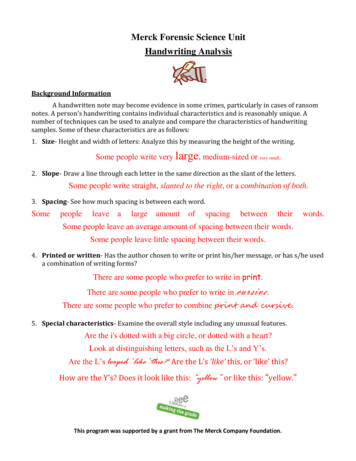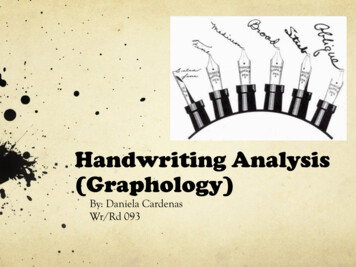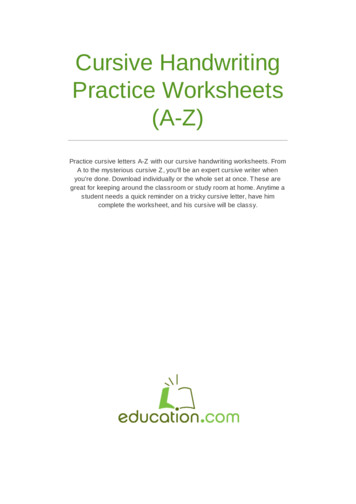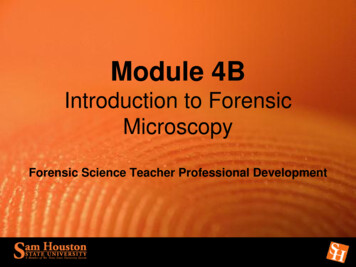
Transcription
Merck Forensic Science UnitHandwriting AnalysisBackground InformationA handwritten note may become evidence in some crimes, particularly in cases of ransomnotes. A person’s handwriting contains individual characteristics and is reasonably unique. Anumber of techniques can be used to analyze and compare the characteristics of handwritingsamples. Some of these characteristics are as follows:1. Size- Height and width of letters: Analyze this by measuring the height of the writing.Some people write very large, medium-sized or very small.2. Slope- Draw a line through each letter in the same direction as the slant of the letters.Some people write straight, slanted to the right, or a combination of both.3. Spacing- See how much spacing is between each word.Somepeopleleave alarge amount ofspacingbetweentheirwords.Some people leave an average amount of spacing between their words.Some people leave little spacing between their words.4. Printed or written- Has the author chosen to write or print his/her message, or has s/he useda combination of writing forms?There are some people who prefer to write in print.There are some people who prefer to write incursive.There are some people who prefer to combine print and cursive.5. Special characteristics- Examine the overall style including any unusual features.Are the i's dotted with a big circle, or dotted with a heart?Look at distinguishing letters, such as the L’s and Y’s.Are the L’s looped ‘like’ this? Are the L’s ‘like’ this, or ‘like’ this?How are the Y’s? Does it look like this: “yellow” or like this: “yellow.”This program was supported by a grant from The Merck Company Foundation.
DirectionsTwo plans are available for you to choose: PLAN A: To present the program as one big groupPLAN B: To present the program with 5 smaller groupsMaterialsoooooooTracing Paper“Ransom Note” Pages“List of Suspects’ Handwriting” Pages“Handwriting Analysis – Observations Worksheet” Pages (8 1/2" x 11" pages)Large “Handwriting Analysis – Observations” Worksheet (three 11” x 17” pages)RulersPaper ClipsBackground Information about Grip, the RavenAt the Central Parkway Branch in the Rare Books Collection, you can visit “Grip” the Raven. Grip isCharles Dickens’ pet raven and it was also a minor character in Dickens’ historical novel, BarnabyRudge, published in weekly installments in 1841. Poe published his poem “The Raven” in 1845. Awidely held belief among Poe scholars is that Poe consciously imitated Dicken’s raven(Information Sheet from the Free Library of Philadelphia, Rare Books Department).Mystery ConnectionOne day, an employee of the Rare Books department came to work and realized that Grip, theraven was missing. Inside the glass case where Grip used to be, there was a ransom note, whichread:To the directer of the Libary,i got the bird up in Central Libary. i think its called “grip the raven” by poe. Unless u got 1,000,000 by tuesday, you not gettin’ it back. i give u more details l8er 2day.Call the cops n you aint gettin nuttin.We need your help!Help us find out who the culprit is. The police have five suspects in custody and we asked them togive us a sample of their handwriting.Can you find out who the culprit is by comparing the different handwriting samples with thehandwritten ransom note?Note: Each child should get a piece of tracing paper, a paperclip, a copy of the “Ransom Note” anda copy of the “Five Suspect’s Handwriting.” Allow the participants to share rulers if there aren’tenough.This program was supported by a grant from The Merck Company Foundation.
DIRECTIONS (PLAN A):These directions are for the presenter of the program. Please do not share this with theparticipants because the answer will be included.Plan A (Present program as one large group):1. Introduce the crime scene.a. You or the participants can read out loud the “Background Information of Grip, theRaven” and the “Mystery Connection.”b. Explain the crime scene and explain that there are five suspects in custody and one ofthem is the culprit who stole Grip, the raven.c. Explain that we will help the police figure out who the culprit is.2. Have the large “Handwriting Analysis- Observations” sheet taped in an area whereeveryone can see it. Use this sheet to record their observations.a. Ask the participants to look over the “Ransom Note” pages and “List of Suspects –Handwriting” pages and compare the handwriting.b. Ask the participants to raise their hands if they have any observations they would liketo share.c. Further engage the participants by asking if they agree/disagree with theirobservations.i. Remind the participants to be respectful to their peers even if they disagree.3. Helpful Hints:If the participants do not know where to start: Go in order, from suspect #1 to suspect #5. Ask the participants why Suspect #1can/cannot be the culprit, following with Suspect #2 etc, until you finish with Suspect#5. Another approach is to point out who they think is definitely not the culprit from thestyle of the handwriting (spacing, size, special characteristics, etc.). Encourage the participants to explain why they feel that a certain suspect is or isn’t theculprit. Use the tracing paper to copy the suspect’s and culprit’s handwriting to compare. Usethis method to compare the handwriting and note observations.4. Finally, determine who the culprit is! (Answer: Suspect 4)This program was supported by a grant from The Merck Company Foundation.
DIRECTIONS (PLAN B):These directions are for the presenter of the program. Please do not share this with theparticipants because the answer will be included.PLAN B (SMALLER GROUPS, ideally with 5 groups):1. Introduce the crime scene.a. You a participants can read out loud the “Background Information of Grip, the Raven”and the “Mystery Connection”b. Explain the crime scene and explain that there are five suspects in custody and one ofthem is the culprit who stole Grip, the raven.c. Explain that we will help the police figure out who the culprit is.2. Break out into 5 small groups, and assign each group two suspects.a. Group A: Suspect 1, 2Group B: Suspect 2, 3Group C: Suspect 3, 4Group D: Suspect 4, 5Group E: Suspect 5, 1Note: You can have the groups make up their own team names (instead of “Group A,Group B etc.), but remember to note it down.b. In their groups, ask the participants to go over their observations of why the suspectsthey are assigned can be or cannot be the culprit.3. After a short discussion (about 5-7 minutes), ask the groups to share their ideas.Sharing info Schedule:SuspectsGroups that will share their ideasSuspect 1Group A&Group ESuspect 2Group B&Group ASuspect 3Group C&Group BSuspect 4Group D&Group CSuspect 5Group E&Group D4. While groups share their ideas, write the ideas on the larger “Handwriting AnalysisObservations” sheet.5. Helpful Hints: If the participants don’t know where to start, go over and point outsome characteristics to get them started.6. Finally, determine who the culprit is! (Answer: Suspect 4)This program was supported by a grant from The Merck Company Foundation.
Ransom Note: Compare the handwriting in the “Five Suspect’s Handwriting” pageto the handwriting here on this ransom note, to find the culprit.This program was supported by a grant from The Merck Company Foundation.
Five Suspect’s Handwriting: Compare the suspects’ handwriting with the ransom noteto find the culprit.Suspect 1:Suspect 2:Suspect 3:Suspect 4:Suspect 5:This program was supported by a grant from The Merck Company Foundation.
Handwriting AnalysisObservations WorksheetSuspect # Observations of Observations ofwhy this suspect why this suspect isispossibly thenot the culpritculpritSuspect1Suspect2This program was supported by a grant from The Merck Company Foundation.
Suspect3Suspect4Suspect5Additional comments:This program was supported by a grant from The Merck Company Foundation.
Merck Forensic Science Unit Handwriting Analysis Background Information A handwritten note may become evidence in some crimes, particularly in cases of ransom notes. A persons handwriting contains individual characteristics and is reasonably unique. A number of techniques can be used to analyze and compar










